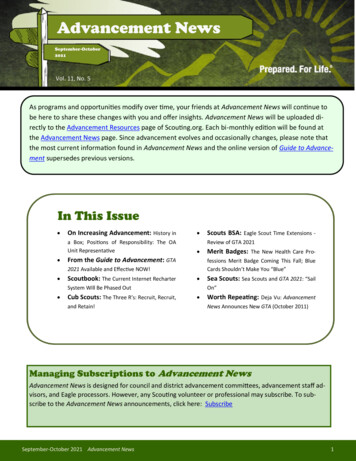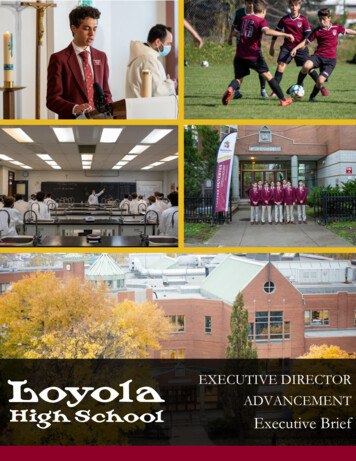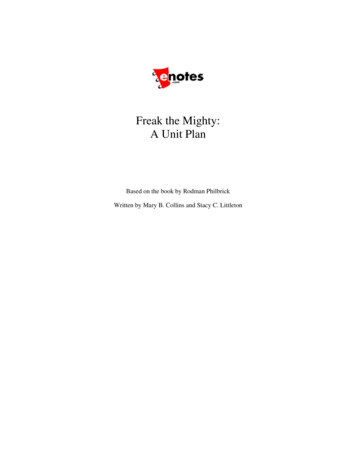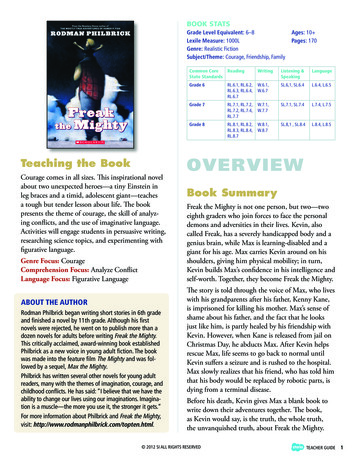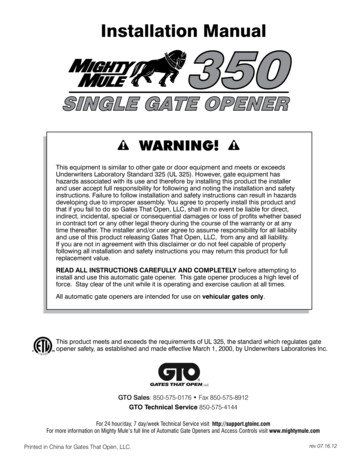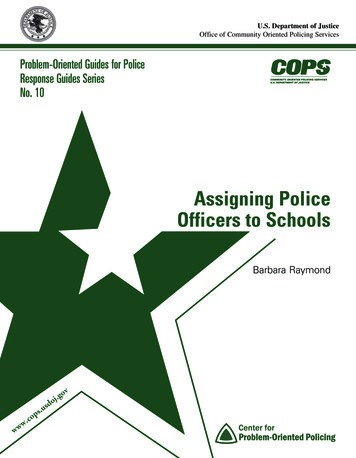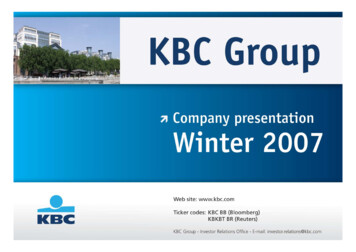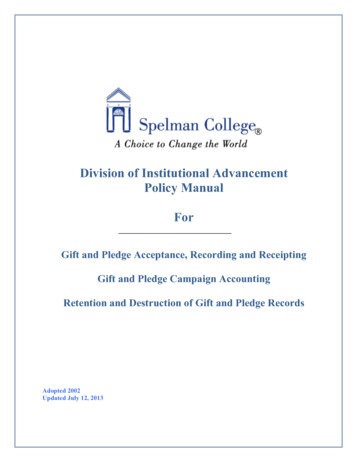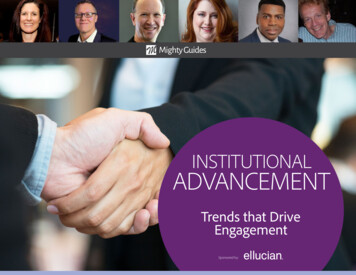
Transcription
INSTITUTIONALADVANCEMENTTrends that DriveEngagementSponsored by:
FOREWORDIn 2016, the New York Times reported that of all the jobs created in the United States since2008, 99 percent went to people who had some college experience; 72 percent went topeople who had at least a bachelor’s degree.Gallup finds that 70 percent of Americans now consider a college education “very important.”In 1979, that figure stood at just 36 percent.Driving the point home, according to the Bureau of Labor Statistics, the percentage of highschool graduates opting for higher education has risen in each of the past three years.Why? A Georgetown University study predicts that 3 million jobs will be left unfilled in 2018because workers lack the requisite skills.We are seeing these trends reflected around the world, and despite what we hear aboutshifting demographics, budget cuts, and the returns on investment students receive, thenumbers point to an era in which student success will drive our shared prosperity like neverbefore.That’s why we’ve asked thought leaders across higher education and the private sector toshare their perspectives on how best to seize the opportunities ahead. Recruiting. Retention.Development. Increasing efficiency. Breaking down the information silos that impedeinformed decision making across the campus. These are just a few of the topics you’ll findcovered in the pages to follow.From best practices to peer recommendations to personal experiences, we’ve tapped intothe collaborative spirit of higher education to help you create a modern, connected campusthat meets every student, faculty, and staff member’s need. We hope this guide is helpful asyou lead your institution into the exciting times ahead.Ellucian is the worldwide leader of softwareand services designed for higher education.More than 2,400 institutions in 40 countriesrely on Ellucian to help enable the mission ofhigher education for over 18 million students.Ellucian provides student informationsystems (SIS), finance and HR, recruiting,retention, analytics and advancementsoftware solutions. With more than 1,400unique deployments of Ellucian’s cloud andSaaS offerings, the company is one of thelargest providers of cloud-based solutions.Ellucian also supports the higher educationcommunity with a range of professionalservices, such as application softwareimplementation, training, education, andmanagement consulting.Visit Ellucian at www.ellucian.comRegards,Jeff RayPresident and CEOEllucianSponsoredby: by:Sponsored22
INTRODUCTIONThese are exciting — and trying — times for higher education. Many institutionsface smaller, tighter budgets but feel the pressure to modernize technologies to staycompetitive.Through a generous partnership with Ellucian, we’ve spoken with 20 institutional leadersand experts to learn more about technology challenges and trends in five key focal areas:student success, cloud computing, analytics, advancement, and talent management.We asked four experts the following question about student advancement:What trends and strategies are you seeing in advancement today and how arethose supported by technology?During these discussions, the experts shared success stories about operational efficiency,student and staff engagement, and degree completion. They also recounted lessonslearned from the challenges they faced while putting new technologies into place.One thing they all agree on is that when implemented properly and executed well, technologyis a platform on which all postsecondary learning institutions can build success. Theseprofessionals also highlighted the need for a holistic view of technology across the institutionand a concrete plan for campuswide deployment as essential for success.I trust you’ll find these experts’ insights and advice useful and that after reading this book,you’ll come away with solid strategies to help advance the use of technology in yourcollege or university.Mighty Guides make you stronger.These authoritative and diverseguides provide a full view of a topic.They help you explore, compare,and contrast a variety of viewpointsso that you can determine what willwork best for you. Reading a MightyGuide is kind of like having your ownteam of experts. Each heartfelt andsincere piece of advice in this guidesits right next to the contributor’sname, biography, and links so thatyou can learn more about their work.This background information givesyou the proper context for eachexpert’s independent perspective.Credible advice from top expertshelps you make strong decisions.Strong decisions make you mighty.All the best,David RogelbergPublisher 2017 Mighty Guides, Inc. I 62 Nassau Drive I Great Neck, NY 11021 I 516-360-2622 I www.mightyguides.comSponsoredby: by:Sponsored33
Institutional AdvancementMark KoenigOregon State UniversityFoundation.5Jenny JonesEllucian.7Sponsoredby: by:SponsoredThomas ChavesLehigh University.11Robert HenryCASE.1344
BEYOND THE ROLODEX: CRM ADDS CRITICAL FUNCTIONALITY FOR HIGHER EDDownload the full e-book: The Future of Higher EducationWhat do university advancement and the private sector havein common? According to Mark Koenig, more than you mightthink — both types of organizations revolve around sales andmarketing.MARKKOENIGAssistant Vice President forAdvancement Services,Oregon State UniversityFoundationMark Koenig is assistant vice presidentfor Advancement Services at theOregon State University Foundation. Hecoordinates the foundation’s fundraisingefforts and oversees research,relationship management, IT services,and database management operations.Taking advantage of his 17 years ofexperience advancing higher education,Mark focuses on the development anduse of funding best practicers.Koenig, assistant vice president for advancement services forthe Oregon State University Foundation, asserts that manyinstitutions have been slow to recognize the link betweenfundraising and marketing. “We must bring a for-profit marketingperspective to higher education,” he recommends. “Frankly, we’remedieval institutions, and we can be glacial at times, but I thinkthat we as an industry have been missing the boat here.”Instead, colleges and universities must think like multichannelmarketers. “At the end of the day, the annual fund is a marketingdivision,” Koenig says. “They do segmentation, they sendout mailings and emails, they may use crowdfunding orcrowdsourcing initiatives, they may use the telefund — theymust manage all the different vehicles through which they runtheir program.”KEYLESSONS1Legacy contactmanagement systems forhigher education keepinformation in silos. Amodern CRM system canconnect to other systemsand opens access tomany more resourcesand data.2Universities can benefitfrom bringing a for-profitmarketing perspective tohigher education.The annual fund is a marketing division. They do segmentation,they send out mailings and emails, they may use crowdfundingor crowdsourcing initiatives . . . . they must manage all thedifferent vehicles through which they run their program.LinkedInSponsoredby: by:Sponsored55
BEYOND THE ROLODEX: CRM ADDS CRITICAL FUNCTIONALITY FOR HIGHER EDTo accomplish their goals, institutions need the same sort of robust customerrelationship management (CRM) systems that businesses do. Selecting the rightsolution for higher education can be challenging, Koenig concedes. “If you look atmost of the major players that market a CRM solution right now, their core legacyproducts are 20 to 30 years old,” he says. What’s more, many were designed more aselectronic Rolodex systems rather than the fully functioning CRM systems availabletoday.Koenig considers a true CRM platform to be one that handles the sales process andintegrates with other tools and systems such as those for call centers, social tracking,and digital marketing campaigns. He notes that a modern CRM system needs to beadaptable and interoperate with other tools.OSU has planned for growth by deploying Ellucian CRM Advance fundraisingsoftware. CRM Advance supports a variety of giving programs through customizabledashboards. “A CRM system lets you control the business workflows so if you’re amajor gift officer, you see the right things. If you’re a gift processing person, you seethe right things. Your business workflows make sense.”A CRM system lets youcontrol the businessworkflows.CRM has many potential uses on campus. “What’s really exciting for us are theautomated marketing features and the ability to link to professional tools for digitalmarketing,” Koenig says.Koenig cites the example of the alumni relations department — most do a good jobof producing alumni magazines. “The process breaks down in how we deliver thosemagazines, who gets them, and why they get them. Do alumni choose to get them?Marketing isn’t always included in this equation,” he explains.Overall, Koenig looks forward to taking advantage of a modern CRM system. “It allowsus to think far more strategically about our data and how we effectively market,” heconcludes.Sponsoredby: by:Sponsored66
FOSTER PERSONAL , PRODUCTIVE ALUMNI RELATIONS WITH CRMDownload the full e-book: The Future of Higher EducationJENNYJONESPrincipal Consultant,EllucianJenny Jones joined Ellucian from theUniversity of North Carolina Charlotte,where she served as the executivedirector for Alumni Affairs. From 2008 to2012, Jenny served as director of AlumniAffairs for the Duke University Schoolof Medicine, and from 2002 to 2008 sheserved as Duke Medicine’s director forSpecial Events and Donor Relations.Jenny holds a bachelor’s degree insecondary education and historyand a master’s degree in educationadministration, both from AppalachianState University.LinkedInBefore her most recent career as a management consultant to thehigher education community, Jenny Jones drove alumni relationsat many institutions, including the University of North CarolinaCharlotte. Over the years, Jones has seen a marked shift fromtraditional, broad-based alumni programs such as annual givingcampaigns toward greater engagement between the alumnus andthe institution.Fortunately, new technology tools facilitate better informationcollection, analysis, and updates for both students and for alumni.“The trend toward personalization drives alumni relations,” Jonessays. “Alumni want to know exactly what they’re giving to; howthe college or university will use these funds; and how theircontribution benefits the institution, student, or faculty member.”KEYLESSONS1The more personalizationyou can create in alumnicommunications throughCRM software, the betterthe results.2Engaging alumni withprojects that interestthem produces moreeffective results.Thankfully, colleges and universities can now deploy customerrelationship management (CRM) systems designed specifically for higher education. Having theright tools makes it easier for institutions to collect meaningful data and harness it to forge personalconnections. “You must figure out how much information you can collect about an individual, andthen successfully match that information to his or her interests,” Jones recommends.Alumni want to know exactly what they’re giving to; howthe college or university will use these funds; and how theircontribution benefits the institution, student, or facultymember.Sponsoredby: by:Sponsored77
FOSTER PERSONAL , PRODUCTIVE ALUMNI RELATIONS WITH CRMJones and her peers have discovered that the more you can relate the ongoingdevelopments of the institution to alumni’s time on campus, the better and moreproductive the relationship will be. “You can gather a lot of information to get a largerpicture of what the students did and with whom they interacted when they were oncampus,” she says.For example, what extracurricular activities did students engage in off campus, andwhat were their interests? “A graduate may have been an archeology major whotraveled abroad and was interested in linguistics. If you know that, you may be ableto fund scholarships for students who are studying archeology or linguistics,” Jonesexplains.Institutions need to be able to pull all those different pieces into a single CRM system,and pinpoint an endowment or scholarship on campus that’s a good match for eachindividual. “Is there a student organization like a Habitat for Humanity chapter that’strying to raise funds? What is it we can send out that the person will open or clickon?” says Jones.Jones acknowledges that getting people to supply personal information after theygraduate can be challenging, but believes that if you give something in return for theinformation, graduates are often receptive. As various IT systems on campus becomemore integrated, data become more useful and persistent across platforms.People are so focusedon technology like CRMright now because theydo not have even themost basic informationabout their alumni.However, many institutions are still in the early stages of their data collectioninitiatives. “People are so focused on technology like CRM right now because they donot have even the most basic information about their alumni,” says Jones. “To get thatinformation, you must make gathering it easy for everyone.”Armed with the right data about current and former students, institutions can moreeasily make connections between people and programs. This boosts engagement andincreases the likelihood for giving.Sponsoredby: by:Sponsored88
FOSTER PERSONAL , PRODUCTIVE ALUMNI RELATIONS WITH CRMJones also has witnessed a shift in the channels used to communicate with prospects. For example, younger donors tend to bemore receptive to social media outreach, text messaging, and email rather than direct mail or phone calls.Technology eases the process of conducting crowdfunding and micro-funding campaigns. “For smaller institutions, technologyis now affordable enough that they can start implementing effective online giving,” Jones says. She recommends providingdonors with the tools to make smaller online donations and offering incentives to turn those smaller donations into recurringgifts. Noting a Pew Research Center that finds that 87 percent of crowdfunding donors value their personal connection to theprojects they support, Jones adds, “The mix of personalization and technology makes online crowd funding possible.”Jones points out that increased awareness of tools for advancement has fostered better collaboration between alumnirelations, communications, marketing, and fundraising. Many institutions are integrating the role that advancementprofessionals play at the highest levels of administration. As advancement technologies and strategies become moresophisticated, institutions need to take advantage of them to raise capital.Sponsoredby: by:Sponsored99
The most important metric is donor retention. By focusing on donorretention, all other metrics rise. Retained donors give more and give for alifetime, so rewarding loyalty is essential. If we don’t retain donors, theywill not grow and influence other donors.LYNNE WESTERFounder, Donor Relations GuruTwitter I Website I LinkedInSponsoredby: by:Sponsored1010
CRM AND SOCIAL MEDIA PAVE THE WAY FOR SENTIMENT ANALYSISDownload the full e-book: The Future of Higher EducationTHOMASCHAVESAssociate VP for Developmentand Alumni Relations,Lehigh UniversityThomas Chaves is a higher educationIT leader who has more than 25years of experience in consulting,product management, development,marketing, and management. He isadept at working with internal andexternal customers to drive new andexisting solutions to proper use andeffectiveness. Tom has presented onindustry trends, market drivers, andtechnology-based approaches tosolving challenges, and he is skilled atusing systems to effectively managethe advanced information needs of auniversity.Thomas Chaves oversees a 22-person team and all thetechnology that supports Lehigh University’s advancementoperations, including prospect research, campaign management,and reporting and analysis. While Chaves appreciates thecustomer relationship management (CRM) tools in place to aidhis goals, he looks forward to taking advantage of sentimentanalysis to propel Lehigh’s advancement initiatives in the future.“We’re starting to work with sentiment analysis, although fromour perspective the technology still isn’t entirely usable,” Chavessays. Sentiment analysis refers to the process of computationallyidentifying and categorizing opinions expressed in text todetermine whether the writer has a positive, negative, or neutralattitude toward a topic or product. Some people also call thisopinion mining.“In higher education, you can more easily get a donation fromalumni when you know what they want to donate to,” Chavessays. “If you can capture alumni sentiment on social media,for example, you can maximize philanthropic support to yourorganization. That’s the real goal.”KEYLESSONS1With unrestrictedgiving on the decline,institutions must learnmore about their alumnito better target theirphilanthropic campaigns.2Sentiment analysis, whichattempts to determinewhether a post (usuallyon social media) ispositive, negative,or neutral, can helpuniversities hypertargetdonors and improvecampaign effectiveness.If you can capture alumni sentiment on social media, you canmaximize philanthropic support to your organization.LinkedInSponsoredby: by:Sponsored1111
CRM AND SOCIAL MEDIA PAVE THE WAY FOR SENTIMENT ANALYSISOffering himself as an example, Chaves suggests that if a charity were to figure out fromsocial media that he’s a New York Mets fan and has two grandchildren, that charitycould likely create a product or offering that capitalizes on those interests. The difficultylies in wading through all the data to flag what’s relevant to that charity, he admits.“You can get to all the data out there at some level, but you need alerts to notifyyou when something significant pops up or when a data point meets a threshold —whatever criteria you set,” Chaves says. Sentiment analysis will prove its usefulness if itcan identify specific alumni for targeted outreach.Donors’ increasing desire to tie giving to their favorite university causes or departmentsdrives the need for more sophisticated CRM tools such as sentiment analysis. “Gettingpeople to give without restrictions is a tough sell,” says Chaves. “Our unrestricted resultshave been pretty flat, but restricted giving keeps climbing. We must figure out how wecan tailor an appeal to maximize effectiveness.”Lehigh University has found success in personalizing campaigns throughhypersegmentation. “The last couple of years, we’ve tailored our phoning and mailing tohone in on more specific cohorts based on their past giving and any other data points wecan find.” Chaves says the institution sees good results from this effort. “We measure thatin LYBUNT (Last Year But Unfortunately Not This Year) retention and number of donors.Our retention is on an upward trend, from low 70 percent a few years ago to 74 to 75percent now. Our donor growth is positive as well, growing about 2 to 3 percent per yearover the last few years.”To truly enhance ourrelationship with alumni,we must understand therest of their lives.To accomplish such granular targeting, Lehigh maintains a core system of record in its baseline CRM system. “We tap into other dataand tie them to that core record to make everything accessible from the university’s information management platform,” Chavesexplains. Integration with several other back-end systems provides a seamless user experience.Overall, Chaves emphasizes the value of information in driving engagement. “We need to recognize that our relationship with alumniconstitutes only a small piece of their lives,” Chaves says. “To truly enhance our relationship with alumni, we must understand the restof their lives.”Sponsoredby: by:Sponsored1212
GENERATIONAL CHANGES REQUIRE NEW ADVANCEMENT PRACTICESDownload the full e-book: The Future of Higher EducationROBERTHENRYVice President, Education,CASERobert Henry is vice presidentof education for the Council forAdvancement and Support ofEducation (CASE), an association thatserves educational institutions andadvancement professionals. Beforejoining CASE, Henry was the directorof individual giving at Yale University;assistant vice president for the Universityof Connecticut Foundation; and taughtin Africa, Europe, Australia, and SouthAmerica. He holds a bachelor’s degreefrom Murray State University and amaster’s degree from Eastern MichiganUniversity.KEYLESSONSWith more than 15 years of experience as a development executive,Robert Henry now shares his expertise with other advancementprofessionals through his work with the Council for Advancementand Support of Education (CASE) association. He advises hismembers to embrace the latest industry trends by adopting newways of approaching prospects and interpreting data.1Henry identifies the first trend as creating a culture of philanthropy.This trend stems from concerns about the role the millennialgeneration will play in future giving. “We know that in the next 8to 10 years, millennials will make up 45 percent of the workforce,”he says, pointing out the tremendous impact millennials will haveon the donor base. Millennials tend to reject institutional giving infavor of crowdfunding or direct support to individuals; a cause ofconcern for many universities.The Millennialgeneration wants to feela connection to a cause,making it necessaryto match donors withspecific programsor individuals at theinstitution.2As students relatemore and more tonontraditional subgroups,institutions must figureout how to engagewith them in ways thatconnect to how they selfidentify.“How do we target Millennials?” Henry asks. “The answer: Increaseengagement. We know that this group wants to have an impact.”Matching the campaign to the prospect is critical for engagingmillennials. “This audience won’t give out of loyalty,” he explains.“For our grandparents, education was a privilege, and they gave outof honor. For millennials, education is an expectation.”For our grandparents, education was a privilege, and they gaveout of honor. For millennials, education is an expectation.Website I LinkedInSponsoredby: by:Sponsored1313
GENERATIONAL CHANGES REQUIRE NEW ADVANCEMENT PRACTICESThe second critical trend concerns diversity, which has recently increased on collegecampuses. These days, students and alumni identify along lines of race, orientation,religion, and other factors but with more nuance and specificity. “How do we engagethese constituents and connect with them in meaningful ways?” Henry posits.Philanthropy becomes a challenge when students no longer identify along the samelines they once did. “Students today don’t put themselves in the boxes that that mygeneration did,” Henry says. “Students see diversity as extremely complex. It’s regional,it’s income — it’s all these pieces. Millennials check ‘other’; they don’t fit into neatboxes.” As a result, an alumni relations program for an affinity group won’t necessarilyappeal to all members of that group.Third, universities must gather and assess alumni engagement metrics. “People inthe fundraising and philanthropy sphere have done a lot of work on how to track thesuccess of their efforts,” Henry says. “We don’t have such metrics for alumni relations,but CASE is developing them now.”Finally, Henry likes the trend toward online giving. Although people who give onlinetend to give less per donation, these donors often sign up for recurring gifts. Therefore,universities must look more at lifelong giving and less at what specific campaigns raise.Institutions will haveto figure out how toencourage online givingwhile still providingdonors with a feeling ofconnection. People needto understand the powerof those smaller gifts.“Institutions will have to figure out how to encourage online giving while still providingdonors with a feeling of connection,” Henry recommends. “People need to understandthe power of those smaller gifts.”Sponsoredby: by:Sponsored1414
The emphasis on hiring data analysts and using analytic tools has hugepotential. That will help nonprofits assess what’s working and what isn’t,demonstrate their impacts, and focus their efforts.ROBERT WEINERbTwitter I Website I Blog LinkedInPresident, Robert L. Weiner ConsultingSponsoredby: by:Sponsored1515
READY TO CLEARYOUR BIGGEST HURDLES?Ensure student successMake better decisionsSimplify integrationStudent lifecycle managementRole-based analyticsHigher education data modelDelight usersMobile and intuitive UXUnlock agilityCloudNavigate changeAdvisory & managed servicesLET’S GET STARTEDwww.ellucian.com/getstarted
Ellucian is the worldwide leader of sotware and services designed for higher education. More than 2,400 institutions in 40 countries rely on Ellucian to help enable the mission of higher education for over 18 million students. Ellucian provides student information systems (SIS), inance and HR, recruiting, retention, analytics and advancement


